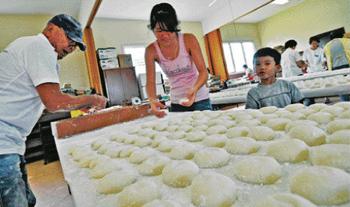KAPA‘A — The waiting list was long at the Kapa‘a Jodo Mission yesterday, as mochi is a hot seller this time of year. “Basically, we have enough for the pre-orders, but there is a waiting list,” said one of the
KAPA‘A — The waiting list was long at the Kapa‘a Jodo Mission yesterday, as mochi is a hot seller this time of year.
“Basically, we have enough for the pre-orders, but there is a waiting list,” said one of the church members who was busy juggling slips of paper containing orders for New Year’s mochi, or rice cakes.
Mochi forms the core of Japanese New Year celebrations and is commonplace in Hawai‘i, where people can purchase commercially-made mochi at supermarkets and other retail outlets.
According to the Japanese National Museum Web site, in North America, Christmas is one of the biggest annual holidays, but in Japan, the most important and elaborate holiday is Oshogatsu, or the celebration of the New Year.
That tradition was brought to Hawai‘i with the Japanese laborers who came to work in the plantations and flourished in the plantation camps that sprang up around the islands, eventually becoming one of the community traditions.
Members of the Kapa‘a Jodo Mission have been making mochi each year in preparation for oshogatsu celebrations. The members also prepare mochi as a fundraiser for other prominent Japanese-based traditions throughout the year, including Boy’s Day, or more recently, Children’s Day which falls on the fifth day of the fifth month.
In times past, other churches around the island prepared mochi, starting out as a service to its largely Japanese membership. But over the years, the churches have been dropping out of this annual task, leaving its members to get mochi from the stores or from churches still gathering for the mochitsuki, or mochi-making process.
“I think we’re the only church making mochi this year,” the church member handling the order slips said. “Hanapepe (Soto Zenshuji Church) is not making this year, so the orders are coming from all over the island.”
Compounding the wait list, the Kapa‘a Jodo Mission used to work through at least 1,000 pounds of special mochi rice. As the years aged its membership and the younger people turning out to help dwindled, so did the amount of rice processed.
Joining the list of absent young people, last year’s turnout of volunteers from the sister Koloa Jodo Mission church left the task to the membership of just the Kapa‘a church.
“This year, we’re just making 700 pounds,” said Gary Furugen, one of the church members helping in the outdoor area where the mochi rice was being steamed before being processed into mochi by an electric-powered machine being manned by other volunteers as well as Rev. Shoryu Akiya, the church’s resident minister.
Mochitsuki is an all-day event which requires many hands, long hours and physical labor, but it is also a time of fellowship and socializing with friends and family, states the Japanese American National Museum Web site.
“Mac Kawamura used to say that you never see your family except when they come to make mochi,” Furugen said. “Now, Ed Kawamura opens his house and has relatives coming from all over when he makes mochi.”
That took place Saturday when M. Kawamura Enterprise was closed for the day for the mochitsuki, said Todd Mayer at the Kaua‘i Interscholastic Federation soccer games.
Derrick Saiki, one of the younger church members, said his family will be pounding mochi on New Year’s Eve at the home of his 90-year-old uncle in Wailua, relying on the traditional kine, or wooden mallet, and usu, or mortar made out of stone.
Compounding the problem of not having enough people coming out to help, Furugen said the mochi making machine is getting old and there are no places to get parts for the machine that was originally made in Japan.
“We’re working with the ‘Junior’ model because the bigger machine broke,” Furugen said. “We can’t even find parts for it because a lot of the parts have been repaired and even re-made. I tried to do a Google search, but even that came up empty.”
One of the older members said he has been making mochi for a long time.
“We come in at 2 in the morning to start the fire to cook the rice,” he said. “In the old days, we had to chop wood, but today, everything is gas, so we don’t need to work so hard. But you still have to come in early.”
The long hours are not without their reward, as some of the church members prepare food for the other members who are involved in the different aspects of mochitsuki as an NFL football game plays on a single TV, providing respite between batches.
“We just get very little sleep,” Akiya said.
• Dennis Fujimoto, photographer and staff writer, can be reached at 245-3681 (ext. 253) or dfujimoto@kauaipubco.com


